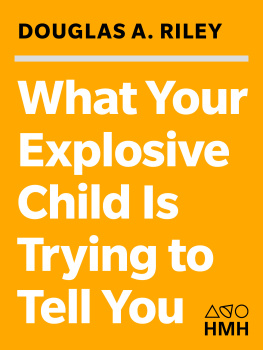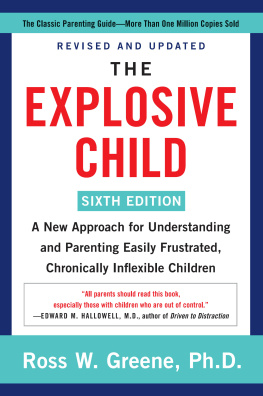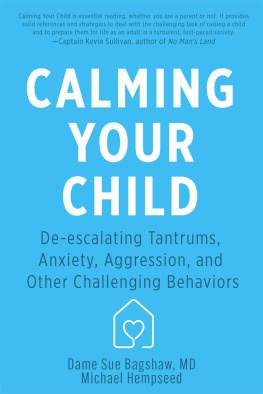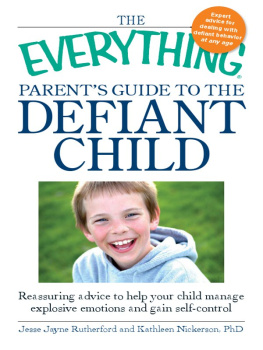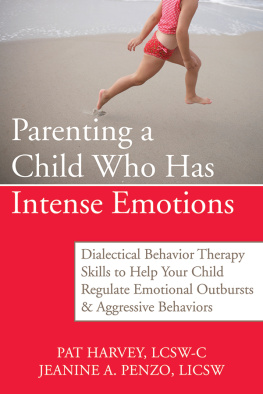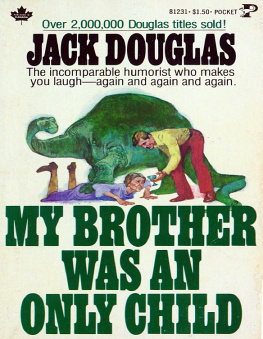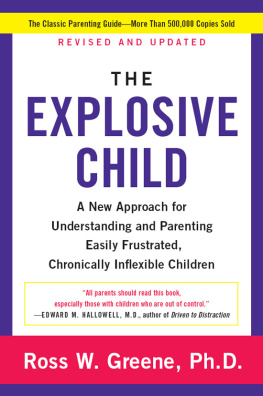Copyright 2008 by Douglas A. Riley
All rights reserved
For information about permission to reproduce selections from this book, write to or to Permissions, Houghton Mifflin Harcourt Publishing Company, 3 Park Avenue, 19th Floor, New York, New York 10016.
www.hmhco.com
The Library of Congress has cataloged the print edition as follows:
Riley, Douglas.
What your explosive child is trying to tell you : discovering the pathways from symptoms to solutions / Douglas A. Riley.
p. cm.
Includes bibliographical references and index.
ISBN 978-0-618-70081-3
1. Behavior disorders in childrenPopular works. 2. Temper tantrums in childrenPopular works. I. Title.
[ DNLM : 1. Child Behavior Disordersprevention & control. 2. Child Behavior Disorderspsychology. WS 350.6 R 573 W 2008]
RJ 506. B 44 R 54 2008
618.92'89142dc22 2008011841
e ISBN 978-0-547-52702-4
v3.1016
Authors Note
None of the names or initials of the children and parents appearing in this book are real. Although it has been my great privilege to work with them, it is also my duty to protect their privacy. Because of this, various details have been changed or modified, and in some cases, composites of several children have been used. The case histories and anecdotes, however, provide highly realistic examples of the types of behavior that explosive children display and the issues that underlie their explosions.
To Debra,
by far my better half
Acknowledgments
M Y UNDERSTANDING OF CHILDREN and their behavior is still a work in progress, even after nearly three decades in the psychologists chair. I have learned from, and continue to learn from, a remarkable array of people over the years. It gives me great pleasure to thank them publicly and to say that I hope this book reflects on them positively and in a way that they would approve of.
The last year has seen the loss of two people central to my development as both a psychologist and a man. My dear friend Dr. Tom Lanning was very much the master of theory in counseling, psychotherapy, and personality testing. He had that daunting ability to read things once and grasp them in all their complexity. However, he much preferred to help others create insight into their lives through his piercing wit and spontaneity, and you could not leave an encounter with him without a smile on your face. Tom died on the evening of a blue moon, and like a blue moon he was rare, the kind of man who does not come along often.
Likewise, the passing of Dr. Robert Betz, professor emeritus in the Department of Counselor Education and Counseling Psychology at Western Michigan University, has left a void in my life, as well as in the lives of those who were lucky enough to have worked with him or to have been mentored by him in their professional lives. Dr. Betz was a professional baseball player, scholar, devoted husband and father, and genealogist, and his clearheaded, commonsense approach to counseling influenced hundreds of us during his long career. I like to believe that he would have read this book and found it to be useful to others, which would have been his highest compliment.
Having the opportunity to work with senior editors at Houghton Mifflin has been something that most writers dream about. Wendy Lazear invited me to join the Houghton Mifflin family (the sort of phone call that any writer would hope to get), and it was her careful guidance and review of my proposal when it was in its infancy that shaped this book into the form it takes today. Jane Rosenman saw me through the actual writing. Jane has ushered the writing of true luminaries to press, and her careful attention to my efforts caused me constantly to sharpen my writing as well as my thinking. I hope that the end result reflects well upon her trust in my ability to explain the behavior of children. Benjamin Steinberg, editorial assistant, kept the project on track, and Beth Burleigh Fuller and Barbara Jatkola, manuscript editor and copy editor, made sure that everything was tightened and honed. The final stages of turning the manuscript into an actual book and bringing it to market were ably handled by Susan Canavan, senior editor, and Elizabeth Lee, editorial assistant. While the flaws in this work are certainly mine, these dedicated professionals deserve credit for their individual and collective contributions to this book, and it is my pleasure to acknowledge them.
I have continued to receive the support and referrals of many pediatricians, nurses, teachers, and school counselors in my area over the years and remain flattered that they turn to me to help in the care and treatment of their patients and students. As always, I remain flattered by the trust that parents extend to me by asking me to work with their children. It is the children themselves who have been my real teachers, and I am thankful for all that they have taught me.
Lastly, and most importantly for me, I wish to thank my family. My sons, Collin and Sam, have grown into the kind of young men that I wish I had been at their ages. They are hard-working, energetic, creative, and giving, and it is my deepest desire, now that this project is finished, that they will still want to spend a few days with me in the mountains stalking trout and howling at the moon. My wife, Debra Lintz-Riley, is literally the foundation upon which this book has been built. She has put up with my long absences while researching and writing about the topics covered here. A remarkable observer of children, with an insatiable drive to get to the bottom of things, her insistence that I treat causes instead of symptoms has had a profound impact upon the way that I think about children and their behavior. I cannot thank her enough for her contributions and her forbearance.
It was six men of Indostan
To learning much inclined,
Who went to see the Elephant
(Though all of them were blind),
That each by observation
Might satisfy his mind.
John Godfrey Saxe
(18161887)
Introduction
T HE OFFICIAL GOAL OF THIS BOOK is to help adults understand explosive children. But in truth its not the adults Im concerned withits the children.
There are important questions to consider. What must it feel like to be the child who is frequently out of control, and no oneparents, teachers, doctorsseems able to offer you the type of help that will allow you to enter into the good graces of others, every childs secret desire, because no one understands why you explode to begin with? As that child, what must it feel like to confront the starespeople always stareon the faces of the children and adults who have watched you blow sky-high yet again, and know that they disapprove not only of what you have done, but also of who you have become? This is a fate that we hope to save our children from, and it is for these children that this book has been written.
Recall the blind men in the ancient Indian parable who were trying to describe the elephant: One, on touching the elephants trunk, said it must be like a snake. Another, after placing his arms around its leg, said elephants must be like trees. And so on, each describing one aspect of the elephants appearance correctly, and in doing so foolishly thinking he had captured the essence of its elephantness.
There is a similar narrow-minded tendency in the mental health field today in which some writers think of explosive behavior as a disorder that can be treated using a single counseling technique, or a particular combination of medications. This one-size-fits-all approach may account for the increasing number of three-, four-, and five-year-olds who, after being kicked out of preschools and private schools because they are considered bad or dangerous are put on layers of medication in order to cure the explosions. After thirty years of working with these children, who, I might add, are as sweet and loving as any other child except during their explosions, it is clear to me that they deserve the same level of effort we place on trying to understand physically ill children or children who are suffering from depression or anxiety.
Next page
